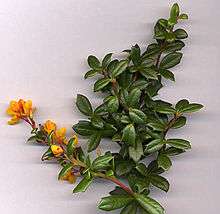Berberidaceae
| Berberidaceae | |
|---|---|
 | |
| Berberis darwinii shoot with flowers | |
| Scientific classification | |
| Kingdom: | Plantae |
| (unranked): | Angiosperms |
| (unranked): | Eudicots |
| Order: | Ranunculales |
| Family: | Berberidaceae Juss.[1] |
| Genera | |
|
See text | |
The Berberidaceae are a family of 14 genera flowering plants commonly called the barberry family. This family is in the order Ranunculales. The family contains about 700 known species,[2] of which the majority are in Berberis. The species include trees, shrubs and perennial herbaceous plants.
Genera
- Achlys
- Berberis – barberry (incl. Mahonia)
- Bongardia
- Caulophyllum
- Diphylleia
- Dysosma
- Epimedium
- Gymnospermium
- Jeffersonia – twinleaf
- Leontice
- Nandina
- Podophyllum – mayapple (incl. and Sinopodophyllum)
- Ranzania
- Vancouveria
The APG II system of 2003 (unchanged from the APG system of 1998) recognises the family and places it in the order Ranunculales in the clade eudicots.
In some older treatments of the family, Berberidaceae only included four genera (Berberis, Epimedium, Mahonia, Vancouveria), with the other genera treated in separate families, Leonticaceae (Bongardia, Caulophyllum, Gymnospermium, Leontice), Nandinaceae (Nandina), and Podophyllaceae (Achlys, Diphylleia, Dysosma, Jeffersonia, Podophyllum, Ranzania).
Mahonia is very closely related to Berberis, and most botanists now include it in Berberis. Species in the two genera can be hybridised, with the hybrids being classified in the (now superfluous) hybrid genus × Mahoberberis. Diphyllaea is closely related or perhaps paraphyletic or embedded in Podophyllum, and instead of the current trend to subdivide Podophyllum into Dysosma and Sinopodophyllum, inclusion of Diphyllaea in Podophyllum is equally warranted.
References
- ↑ Angiosperm Phylogeny Group (2009). "An update of the Angiosperm Phylogeny Group classification for the orders and families of flowering plants: APG III" (PDF). Botanical Journal of the Linnean Society. 161 (2): 105–121. doi:10.1111/j.1095-8339.2009.00996.x. Retrieved 2013-07-06.
- ↑ Christenhusz, M. J. M. & Byng, J. W. (2016). "The number of known plants species in the world and its annual increase". Phytotaxa. Magnolia Press. 261 (3): 201–217. doi:10.11646/phytotaxa.261.3.1.
External links
| Wikimedia Commons has media related to Berberidaceae. |
- Berberidaceae, Leonticaceae, Nandinaceae, Podophyllaceae in L. Watson and M.J. Dallwitz (1992 onwards), The families of flowering plants.
- Berberidaceae links
- NCBI Taxonomy Browser: Berberidaceae
- Flora of North America: Berberidaceae
- Chilean Berberidaceae, by Chileflora